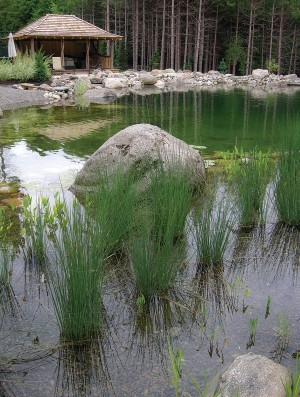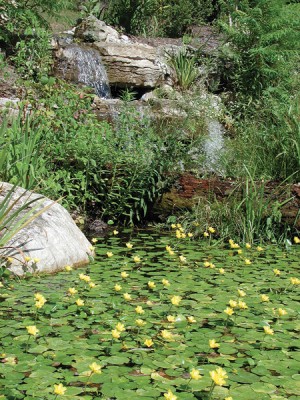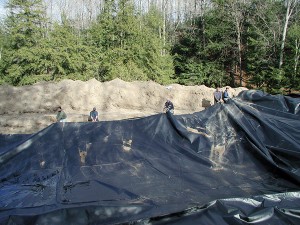No Ordinary Swimming Pool, No Ordinary Pond
If you get the plants right, everything else pretty much falls into place.

This swimming pond, designed by David Warburton, uses the natural filtering properties of rocks and plants to keep the water clear and free of algae. Photo by Rosemary Hasner / Black Dog Creative Arts.
One morning last summer, Hockley landscape designer David Warburton arrived at the site of his latest project to find his client, an international businessman with a hectic schedule, sitting alone beside the spectacular new pond that Warburton had recently designed and constructed in the woods behind the client’s weekend home in the Town of Mono.
As Warburton approached, the client looked up from where he was perched on one of the great granite boulders lining the water’s edge. Beside him in the shallows, dragonflies hovered among the reeds and rushes. Swallows swooped overhead and the early morning sun peeking through the trees cast streaks of silver on the dark, rippled surface of the water.
“I’m just getting my fix before I go back to the city,” said the client, a wistful note in his voice.
“It was one of the happiest moments of my career,” says Warburton recalling the incident. “Here is where he goes, this busy man, to decompress, to get centred.”
“When,” the client asked Warburton, “did you and your crew realize that you were making art?”
And indeed, this 10,000-square-foot piece of watery paradise is no ordinary pond. As natural as it appears on a fine morning in June with its boulder-strewn banks and gravel bottom, its 12-foot depths fed by a sparkling brook that tumbles and cascades over rocky waterfalls into pools of water lilies and cattails – as natural as it looks, this pond is entirely human-made.
Warburton’s idyllic creation is what is known as a “swimming pond.” Chemical-free alternatives to in-ground pools, natural swimming ponds have become hugely popular in Europe and the U.K. because, instead of chlorine, they use the natural filtering properties of plants and rocks to keep the water clear and clean. Now, as awareness of environmental issues spreads, North Americans’ interest in these human-made ponds is growing, especially for rural property owners where spring-fed ponds may not be feasible.
One year earlier, the summer before Warburton’s client calmed himself by the banks of his new pond, the site was a dry-as-a-bone tract of reforested pine. The tennis court had just gone in beside the house and the client and his family now wanted a place to swim.
“We dug a deep test hole in the woods,” says Warburton, “and we did not find a drop of water.” The client was resigned to the idea of installing a conventional in-ground swimming pool, until Warburton suggested an alternative.
“I had been reading a lot about swimming ponds, which are very big in Europe and the U.K.,” he says. “So I called my friend Jean-Marc Daigle because I knew he had done several.”
Daigle, who owns a Schomberg-based design and construction firm, had so far installed two swimming ponds, one in King City and the other in Loretto. With Daigle’s guidance, Warburton undertook what has turned out to be the project of a lifetime.
“The whole project had a kind of karma,” he says. “Things just flowed from one idea to the next.”
In order to generate ideas for the pond, Warburton, who describes himself as “an artist and a gardener,” spent a week canoeing in the Adirondack region of upper New York State. “I was very observant of the natural setting, such as the way rocks sat on the edge of the streams and that sort of thing, so I would have it on my retina when I got back,” he says. “We wanted it so that people couldn’t tell that it was a constructed pond.”

A carpet of water lilies and other plants gives a natural feel to this large swimming pond installed by Randy Tumber near Mansfield in the sandy bank of a ravine. Photo Courtesy Tumber & Associates.
First he and his team had to remove hundreds of the reforested pines to make room for the planned 80-foot by 120-foot pond (about three or four times the size of a conventional swimming pool). Then they carved out a vast pear-shaped crater in the sandy soil and lined it with a thick rubber membrane.
“The liner needs to be as strong as it can be and still be manoeuvrable,” says Warburton. “That’s because it has to withstand the placement and chafing of the huge granite boulders that line the swimming pond edges.”
Why granite? Because, he says, unlike limestone, which is most commonly found along this section of the Niagara Escarpment, granite is naturally acidic, a fact that contributes to the water clarity by helping to break down organic matter.
Granite is also inert, which means it won’t dissolve and make the water murky. But granite is not common in the Headwaters region and Warburton anticipated having to import it (lots of it) at substantial cost from north of Huntsville.
However, by a stroke of luck, he discovered that the fenceline across the road from the pond site was littered with enormous pink granite boulders (likely dumped there eons ago by a glacier passing through), enough to line the edges of the pond as well as a smaller, ornamental pond he was digging closer to the house, and to form the elaborate, cascading stream that flows from one to the other. One of the rocks was so big, he says, that a 12-yard bucket was needed to move it.
Once the rocks, gravel and liner were in place, Warburton pumped water from a nearby natural pond (one that had plenty of water) until the crater was full.
The hole itself, 12 feet deep at the bottom end of the pear, has a shallow gravelled area at the top end (for children and non-swimmers). The perimeter of the pond is also shallow and covered with a three-foot-wide layer of granite gravel to protect the rubber liner from the sun’s UV rays.
Water plants (rushes, reeds and water lilies) were planted in the gravel layer on the far side of the pond. Known as the “root zone,” it is the pond’s natural filter system, and it is crucial to the success of the pond.
“If you get the plants right, everything else pretty much falls into place,” says Daigle. This spring at his Loretto-area pond project, a similar, though much smaller project than Warburton’s, Daigle planted typical wetland plants – sedges, horsetail, Joe-pye weed and marsh marigold on the banks, and, in the root zone, cattails, bulrushes, sedges, duckweed and water lilies.
The plants clean and filter the water in a complex variety of ways that ecologists are only beginning to understand. Daigle and his partner, Simon Dold, have been experimenting, trying to get the right “mix” of plants by observing how they act in a natural setting. Figuring out, for instance, how the leaves of some plants act to remove certain nutrients from the water and thereby restrict the growth of algae, while the roots of other plants actually emit toxins that destroy the algae.
“The plants have powerful filtering properties,” says Warburton. But as extra ammunition against the demon algae, he adds that “the granite gravel in the swimming pond is inoculated with a kind of bacteria that breaks down organic matter – leaves, grass, pine needles, etc.” Algae feed on organic matter, so the trick is to keep it below a certain level so that the algae can’t bloom. The bacteria, he says, are harmless and naturally occurring, “what you’d find in any lake or stream.”
Keeping the algae at bay is an ongoing challenge with swimming ponds, particularly in hot weather. It’s important to keep the water plants healthy and the water in the pond moving. To that end, a small pump keeps the water circulating through the planting area. Warburton also pumped water via an underground line from the main pond up to the ornamental pond near the house; the water then runs back down through the rocky stream in a constant circular flow.
And in summer, if the water drops below a certain level, a float system triggers a pump from the well to top things off.
E.coli, too, can be a problem, particularly if wild ducks visit the pond. “One duck creates more E.coli than a single cow,” says Daigle. At his Loretto swimming pond, he runs the water through UV lights as a precaution. But they need to be used judiciously because the lights can destroy good bacteria along with E.coli.
“The beauty of these ponds,” says Daigle, “is that, unlike concrete pools, they look great even when you’re not swimming in them.” And not only are they chemical-free, once the plants are in place, they’re virtually maintenance-free too. At most, Warburton advises pulling out the plants as they die back in the fall and composting them.
So, are swimming ponds poised to become as popular here as they are in Europe? (In France, says Daigle, natural ponds now outnumber conventional swimming pools. An estimated 50,000 of the ponds have been constructed in Germany, Austria and Switzerland in the last twenty years.)

Tumber’s crew shimmies a huge rubber liner into place at the Mansfield site. Photo Courtesy Tumber & Associates.
Not according to Orangeville-based landscape consultant Randy Tumber. His company, which specializes in the rehabilitation of existing ponds, has also installed lined swimming ponds, most recently a large one for a client near Mansfield.
“The concept is wonderful,” Tumber says, “and people love the idea of going green, but as soon as you tell them they can’t heat a natural pond above 70 degrees, they lose interest.” He says that the trend has caught on with Europeans because “they are hard-core environmentalists. That’s because their environment has been much more degraded than ours.”
Then there’s the cost. Even though he was lucky enough to find all that granite in a field across the road, Warburton’s Mono client still paid in the low to mid six figures for his human-made Walden, making it a less financially feasible alternative to an in-ground pool for most people.
Warburton admits that his pond project is “tremendously elaborate. It could be a lot simpler,” he says.
But most of the swimming ponds that have been built in North America to date tend to be large, expensive projects. Tumber thinks that’s because, unlike Europeans, we have the luxury of space and if we’re going to have a pond, well, we want it to be a big one. He continues to see swimming ponds primarily as a niche market in this country, for people with very deep pockets.
According to Daigle, another stumbling block is that North Americans are “more squeamish” about the idea of sharing their swimming space with real live flora and fauna (the frogs, fish, water bugs and myriad plants that drive the natural technology).
But he says that it is possible to make swimming ponds more like conventional pools by situating the planting zone off to the side in a separate pond and pumping the water through it. And, according to the U.K. website (www.gartenart.co.uk), existing conventional swimming pools can be converted to natural filter systems by simply adding a shallow plant area around the outside.
Daigle also takes issue with Tumber’s assertion that the ponds cannot be heated. “We’ve installed one with a heater for use in the spring and fall,” he says, adding that there’s actually an advantage to heating the water in the spring because the warmth activates the bacteria, so that they destroy the organic matter before the algae can feed on it.
As for cost, Daigle says that a modest swimming pond like the one he built in Loretto with a 16-foot by 30-foot swim zone would cost between $40,000 and $50,000, including aquatic plantings, a dock, a waterfall and a pump system.
Warburton estimates a “bare-bones” 20-foot by 40-foot swimming pond should cost about the same as a good quality conventional pool – around $80,000.
Yet another obstacle is the difficulty of obtaining permits from local authorities. In many jurisdictions (and that includes the four conservation authorities in the Headwaters region) rising concerns about the effects that ponds have on groundwater, wetlands and existing water courses mean that permits are increasingly hard to come by. Oddly, this applies not just to the construction of conventional spring-fed ponds, but the human-made variety too.
Tumber’s Mansfield client originally wanted to dig a spring-fed pond in a ravine on his property where he knew there was water, but the local conservation authority refused to issue a permit because the site was “on-line” (meaning it was on an existing watercourse). Instead Tumber constructed the pond in the pure sand higher up on the side of the ravine, using a liner to hold water that was pumped in.
“These days it’s almost impossible to get a permit to put a pond on-line,” he says, adding “And that’s a good thing. You really want to make sure you work closely with the conservation authorities. We try to do everything in harmony with nature.”
As for David Warburton, he still can’t get over how much the landscaped water feature he conceived and built from nothing resembles the Adirondack woodland settings that inspired it.
“As an artist, I’ve painted lots of northern landscapes, but this was going one better,” he says. “My whole prejudice was to have the entire thing as natural as possible.”
Has he succeeded? Warburton thinks so. “Now this whole place just echoes with water.
More Info
- David Warburton, Plantsmen
- Randy Tumber, Tumber & Associates Landscape Consultants
www.tumber.ca - Jean-Marc Daigle, Genus Loci Ecological Landscapes
www.genus-loci.ca






